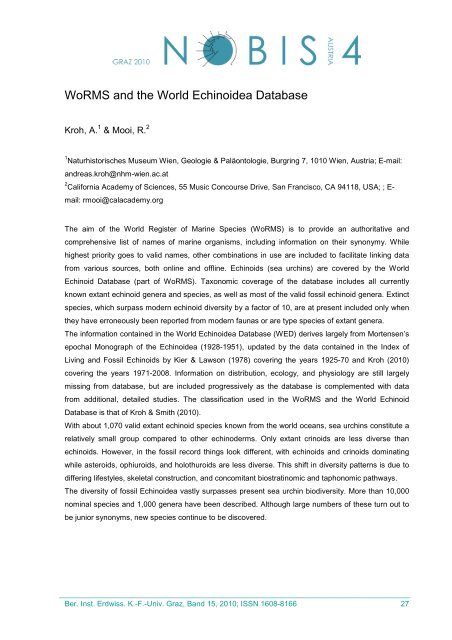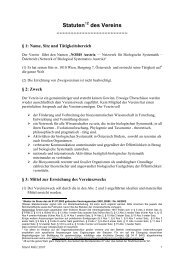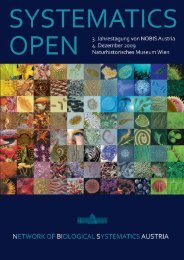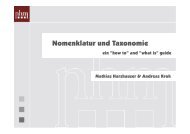4. Jahrestagung von NOBIS Austria 2. - 3. Dezember 2010
4. Jahrestagung von NOBIS Austria 2. - 3. Dezember 2010
4. Jahrestagung von NOBIS Austria 2. - 3. Dezember 2010
You also want an ePaper? Increase the reach of your titles
YUMPU automatically turns print PDFs into web optimized ePapers that Google loves.
WoRMS and the World Echinoidea Database<br />
Kroh, A. 1 & Mooi, R. 2<br />
1 Naturhistorisches Museum Wien, Geologie & Paläontologie, Burgring 7, 1010 Wien, <strong>Austria</strong>; E-mail:<br />
andreas.kroh@nhm-wien.ac.at<br />
2 California Academy of Sciences, 55 Music Concourse Drive, San Francisco, CA 94118, USA; ; E-<br />
mail: rmooi@calacademy.org<br />
The aim of the World Register of Marine Species (WoRMS) is to provide an authoritative and<br />
comprehensive list of names of marine organisms, including information on their synonymy. While<br />
highest priority goes to valid names, other combinations in use are included to facilitate linking data<br />
from various sources, both online and offline. Echinoids (sea urchins) are covered by the World<br />
Echinoid Database (part of WoRMS). Taxonomic coverage of the database includes all currently<br />
known extant echinoid genera and species, as well as most of the valid fossil echinoid genera. Extinct<br />
species, which surpass modern echinoid diversity by a factor of 10, are at present included only when<br />
they have erroneously been reported from modern faunas or are type species of extant genera.<br />
The information contained in the World Echinoidea Database (WED) derives largely from Mortensen’s<br />
epochal Monograph of the Echinoidea (1928-1951), updated by the data contained in the Index of<br />
Living and Fossil Echinoids by Kier & Lawson (1978) covering the years 1925-70 and Kroh (<strong>2010</strong>)<br />
covering the years 1971-2008. Information on distribution, ecology, and physiology are still largely<br />
missing from database, but are included progressively as the database is complemented with data<br />
from additional, detailed studies. The classification used in the WoRMS and the World Echinoid<br />
Database is that of Kroh & Smith (<strong>2010</strong>).<br />
With about 1,070 valid extant echinoid species known from the world oceans, sea urchins constitute a<br />
relatively small group compared to other echinoderms. Only extant crinoids are less diverse than<br />
echinoids. However, in the fossil record things look different, with echinoids and crinoids dominating<br />
while asteroids, ophiuroids, and holothuroids are less diverse. This shift in diversity patterns is due to<br />
differing lifestyles, skeletal construction, and concomitant biostratinomic and taphonomic pathways.<br />
The diversity of fossil Echinoidea vastly surpasses present sea urchin biodiversity. More than 10,000<br />
nominal species and 1,000 genera have been described. Although large numbers of these turn out to<br />
be junior synonyms, new species continue to be discovered.<br />
_____________________________________________________________________________<br />
Ber. Inst. Erdwiss. K.-F.-Univ. Graz, Band 15, <strong>2010</strong>; ISSN 1608-8166 27






